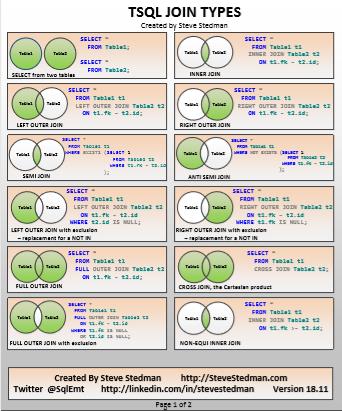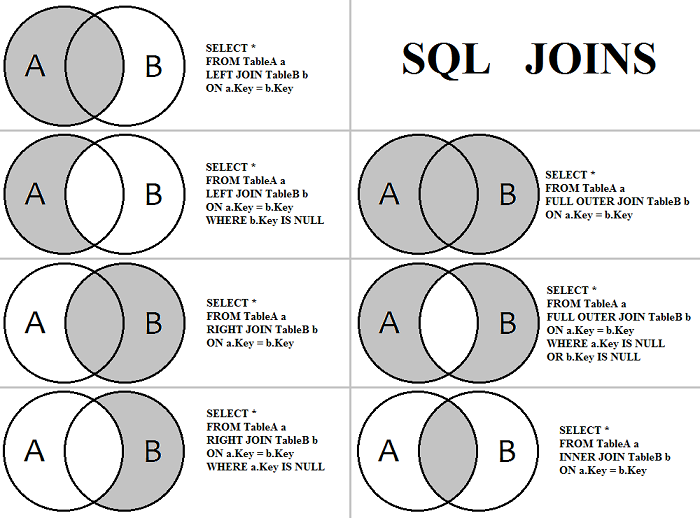The easiest and most intuitive way to explain the difference between these four types is by using a Venn diagram , which shows all possible logical relations between data sets. Here are the different types of the JOINs in SQL: (INNER) JOIN: Returns records that have matching values in both tables. LEFT (OUTER) JOIN: Return all records from the left table, and the matched records from the right table. RIGHT (OUTER) JOIN: Return all records from the right table, and the matched records from the left table. Inner joins return all rows from two or more tables that meet the join condition.
Sample SQL SELECT columns FROM TableA INNER JOIN TableB ON A. SQL JOIN and different types of JOINs - Stack. Cross JOIN is a simplest form of JOINs which matches each row from one database. The inner JOIN is used to return rows from both tables that satisfy the given condition. SQL Server LEFT OUTER JOIN (or sometimes called LEFT JOIN ). A join is a method of linking data between one or more tables based on values of the common column between the tables.
Understanding Hash joins. Moreover, a variant of the hash join can do duplicate removal and grouping, such as SUM (salary) GROUP BY department. MySQL Outer JOINs return all.
Create PHP web Forms and Reports. There are many types of join. No programming required. The join that displays only the rows that have a match in both the joined tables is known as.
The SQL has four types of JOINs. Depending on the requirement of the recordset, you may choose which one to choose. If you simply use JOIN keywor it is taken as INNER JOIN. The INNER JOIN only returns the matched records from both tables. The diagram shows the following: INNER JOIN , LEFT OUTER JOIN , RIGHT OUTER JOIN , LEFT OUTER JOIN with exclusion, RIGHT OUTER JOIN with exclusion, FULL OUTER JOIN , FULL OUTER JOIN with exclusion, two INNER JOINs, two FULL OUTER JOINs,.
The simplest Join is INNER JOIN. This keyword will create the result-set by combining all rows from both the tables where the condition satisfies i. SQL HOME SQL Intro SQL Syntax SQL Select SQL Select Distinct SQL Where SQL An Or, Not SQL Order By SQL Insert Into SQL Null Values SQL Update SQL Delete SQL Select Top SQL Min and Max SQL Count, Avg, Sum SQL Like SQL Wildcards SQL In SQL Between SQL Aliases SQL Joins SQL Inner Join SQL Left Join SQL Right Join SQL Full Join SQL Self Join SQL. Since SQL joins appear to be set-base the use of Venn diagrams to explain them seems, at first blush, to be a natural fit.
A JOIN is a means for combining columns from one (self- join ) or more tables by using values common to each. ANSI-standard SQL specifies five types of JOIN : INNER, LEFT OUTER, RIGHT OUTER, FULL OUTER and CROSS. As a special case, a table (base table, view, or joined table) can JOIN to itself in a self- join. This is similar to INNER JOIN , but here you retrieve all the rows from the left, right or both of the tables regardless of matching rows in another table. This join returns all matched rows from the right table and all matched as well as unmatched rows from the left table.

The gray rectangles are abstract types of joins (see the difference between Inner and Equi join below). Cross Join (Cartesian product) The Cross join is the most generic type of join , it generally means connect anything with anything. Its result is the number of records in the first table multiplied by the number of records in the second table. You can use multiple tables in your single SQL query.
Note that LEFT and RIGHT OUTER are normally truncated to LEFT or RIGHT. An OUTER JOIN defaults to LEFT. The point here is that it’s impossible to use SQL to join your data without a data warehouse, and the easiest way to connect your many sources is through an ETL tool. A well-designed database will provide a number of tables containing related data. If the join predicate evaluates to TRUE, the column values of the matching rows of Tand Tare combined into a new row and included in the result set.

The following table illustrates the inner join of two tables T(3) and T(A,B,C). The result includes rows: (A) and (B) as they have the same patterns. Join hints enforce a join strategy between two tables.
If a join hint is specified for any two tables, the query optimizer automatically enforces the join order for all joined tables in the query, based on the position of the ON keywords.
Nincsenek megjegyzések:
Megjegyzés küldése
Megjegyzés: Megjegyzéseket csak a blog tagjai írhatnak a blogba.